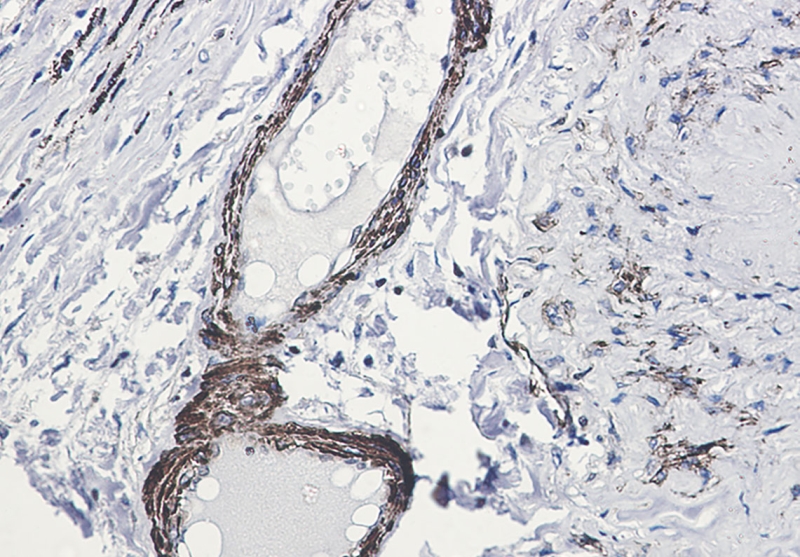

| WB | 咨询技术 | Human,Mouse,Rat |
| IF | 1/20 | Human,Mouse,Rat |
| IHC | 1/50-1/100 | Human,Mouse,Rat |
| ICC | 技术咨询 | Human,Mouse,Rat |
| FCM | 咨询技术 | Human,Mouse,Rat |
| Elisa | 咨询技术 | Human,Mouse,Rat |
| Aliases | ARB1; ARR1; ARRB1; ARRB1_HUMAN; Arrestin 2; Arrestin beta 1; Arrestin beta-1; Beta-arrestin-1. |
| Entrez GeneID | 408 |
| WB Predicted band size | Calculated MW: 47 kDa; Observed MW: 50 kDa |
| Host/Isotype | Rabbit IgG |
| Antibody Type | Primary antibody |
| Storage | Store at 4°C short term. Aliquot and store at -20°C long term. Avoid freeze/thaw cycles. |
| Species Reactivity | Human |
| Immunogen | A synthetic phosphopeptide corresponding to residues surrounding Ser412 of human beta Arrestin 1 |
| Formulation | Purified antibody in TBS with 0.05% sodium azide,0.05%BSA and 50% glycerol. |
+ +
以下是关于Phospho-beta Arrestin 1 (Ser412)抗体的3篇参考文献示例(注:以下为模拟内容,实际文献需根据具体数据库检索):
---
1. **文献名称**: *"Phosphorylation of β-Arrestin1 at Ser412 Regulates Its Trafficking and Signaling in GPCRs"*
**作者**: Luttrell LM et al.
**摘要**: 本文研究了β-arrestin1在Ser412位点的磷酸化对其在GPCR信号通路中的作用。通过使用特异性抗体,作者发现该磷酸化事件增强了β-arrestin1与Clathrin的结合能力,促进受体内化,并调控MAPK信号通路的激活。
2. **文献名称**: *"Site-Specific Phosphorylation of β-Arrestin1 Modulates Its Interaction with Inflammatory Receptors"*
**作者**: Shenoy SK et al.
**摘要**: 研究利用Phospho-Ser412抗体证明,炎症因子刺激下β-arrestin1的Ser412磷酸化是其与TLR4受体结合的关键步骤,揭示了该位点磷酸化在先天免疫反应中的调控机制。
3. **文献名称**: *"Antibody-Based Detection of β-Arrestin1 Phosphorylation Reveals Roles in Cancer Cell Migration"*
**作者**: Zoudilova M et al.
**摘要**: 通过Western blot和免疫荧光分析,作者使用Phospho-Ser412抗体证实,乳腺癌细胞中β-arrestin1的Ser412磷酸化水平升高与细胞迁移和侵袭能力相关,提示其作为潜在治疗靶点。
---
如需具体文献,建议通过PubMed或Google Scholar以关键词“Phospho-beta Arrestin 1 Ser412 antibody”检索,并筛选涉及抗体应用或功能机制的研究。
**Phospho-beta Arrestin 1 (Ser412) Antibody Background**
Beta-arrestin 1 (ARRB1) is a multifunctional adaptor protein critical in regulating G protein-coupled receptor (GPCR) signaling. Upon receptor activation, beta-arrestin 1 is recruited to phosphorylated GPCRs, facilitating receptor desensitization, internalization, and initiation of downstream signaling pathways. Phosphorylation at Ser412 is a key post-translational modification that modulates beta-arrestin 1’s conformational state, influencing its interactions with receptors, clathrin, and other signaling effectors. This phosphorylation event, often mediated by kinases such as ERK1/2. enhances beta-arrestin’s scaffolding functions, promoting MAPK pathway activation or receptor trafficking.
The Phospho-beta Arrestin 1 (Ser412) antibody specifically detects beta-arrestin 1 when phosphorylated at Ser412. serving as a vital tool to study GPCR signaling dynamics, receptor internalization, and arrestin-dependent signaling cascades. Researchers use this antibody in techniques like Western blotting, immunofluorescence, or immunoprecipitation to investigate phosphorylation-dependent mechanisms in cellular contexts, including immune regulation, cancer progression, and neurological disorders. Its application helps elucidate how beta-arrestin 1’s phosphorylation status fine-tunes cellular responses to extracellular stimuli, offering insights into therapeutic targets for diseases involving dysregulated GPCR signaling. Validation of the antibody includes testing specificity via knockout controls or phosphopeptide competition assays.
×